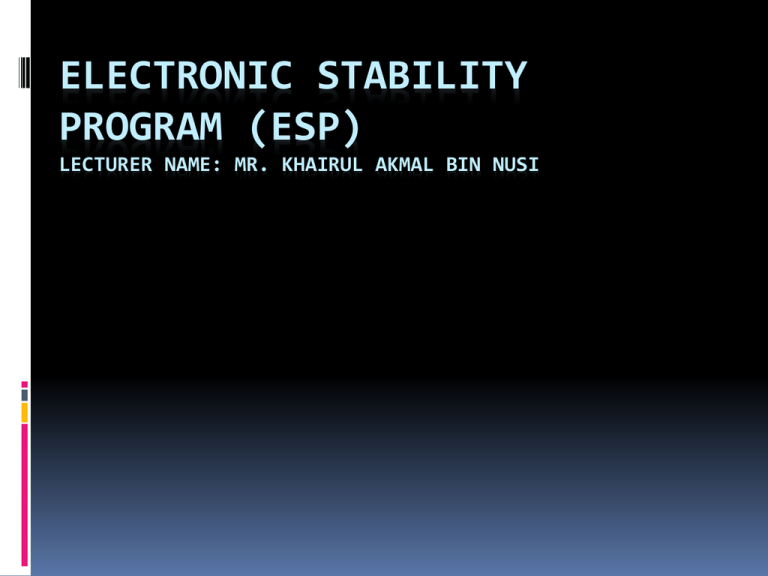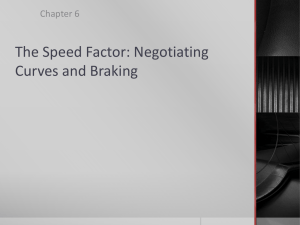electronic stability program (esp) - ja505
advertisement

ELECTRONIC STABILITY PROGRAM (ESP) LECTURER NAME: MR. KHAIRUL AKMAL BIN NUSI Introduction Electronic stability control (ESC), also referred to as electronic stability program (ESP) or dynamic stability control (DSC), is a computerized technology that improves the safety of a vehicle's stability by detecting and reducing loss of traction (skidding) Operation of the ESP When ESP detects loss of steering control, it automatically applies the brakes to help "steer" the vehicle where the driver intends to go. Braking is automatically applied to wheels individually, such as the outer front wheel to counter oversteer or the inner rear wheel to counter understeer. Some ESP systems also reduce engine power until control is regained. ESP does not improve a vehicle's cornering performance; instead, it helps to minimize the loss of control. Electronic Stability Program diagram ESP Control Modes Normal modes During normal driving, ESP works in the background and continuously monitors steering and vehicle direction. It compares the driver's intended direction (determined through the measured steering wheel angle) to the vehicle's actual direction (determined through measured lateral acceleration, vehicle rotation (yaw), and individual road wheel speeds). ESP Off Mode Many ESP systems have an "off" override switch so the driver can disable ESP, which may be desirable when badly stuck in mud or snow, or driving on a beach, or if using a smaller-sized spare tire which would interfere with the sensors ESP with sport mode The Electronic Stabilization Program (ESP) adds to that reassurance without numbing the performance thanks to its Sport mode. The system will brake wheels individually and modulate the engine’s power output to rescue the situation if it detects you have lost control. So you can enjoy the car’s supreme handling to the full. ESP With ASR Mode (acceleration slip regulation) ASR improves traction and can help the driver maintain control even if the limit of adhesion is inadvertently reached while cornering. In addition, it reduces tire wear. ASR activation, is indicated by a flashing light in the instrument cluster; it works with the electronic differential lock (EDL) and it is also part of the electronic stabilization program (ESP). ASR can be deactivated with the ESP switch. ESP With ABS Mode ESP also uses traction control for driving safety. If the traction control system is detecting wheel slippage, the electronic stability control sensor will pick up on the direction of the slide. If there's a difference between the angle of the steering wheel and the direction the car is sliding, the ESP will work with the traction control system to engage the ABS at the proper wheel (or wheels) and control the throttle to reduce the speed of the vehicle. ESP with EBR mode ESP complements the familiar functions of the engine braking regulation (EBR). EBR reduces brake slip at the drive wheels during deceleration and ensures directional control. Adaptive Brake Light Adaptive Brake Light During heavy braking from a vehicle speed greater than 50km/h, the Electronic Stability Program ESP® activates the new "Adaptive Brake Light" safety function, which makes the brake lights flash instead of just lighting up continuously. Once the danger has passed and the brake pedal is only held or slightly released by the driver, ESP® deactivates the "Adaptive Brake Light" and the brake lights light up continuously as usual. These flashing brake lights ensure a higher level of attention on the part of following traffic. Components of ESP 1.ESP-Hydraulic unit with integrated ECU 2.Wheel speed sensors 3.Steering angle sensor 4.Yaw rate sensor with integrated acceleration sensor 5.Engine-management ECU for communication Electronic Sensor: Wheel-speed sensors: One wheel-speed sensor at each wheel measures the speed of the wheel which the computer can then compare to the speed of the engine. Steering-angle sensors:This sensor, in the steering column, measures the direction the driver intends to aim the car. If it's different than the direction the car is actually traveling, the ESP system will kick in. Rotational-speed sensor:This is also known as the yaw sensor. It's the one in the middle of the car that measures the side-to-side motion of the vehicle. Hydraulic Component ESP uses a hydraulic modulator to assure that each wheel receives the correct brake force. A similar modulator is used in ABS. ABS needs to reduce pressure during braking, only. ESP additionally needs to increase pressure in certain situations and an active vacuum brake booster unit may be utilized in addition to the hydraulic pump to meet these demanding pressure gradients. Yaw Rate Control ESP incorporates yaw rate control into the antilock braking system (ABS). Yaw is a rotation around the vertical axis; i.e. spinning left or right. Anti-lock brakes enable ESP to brake individual wheels. Many ESP systems also incorporate a traction control system (TCS or ASR), which senses drive-wheel slip under acceleration and individually brakes the slipping wheel or wheels and/or reduces excess engine power until control is regained. However, ESP achieves a different purpose than ABS or Traction Control An Electronic Stability Program system on Mercedes Benz S550 Different between vehicle using ESP and without using ESP Vehicle without ESP ® Vehicle approaches an obstacle Vehicle goes off course, enters oncoming traffic lane and driver loses control Counter steering causes the vehicle to go into a skid Vehicle with ESP ® Vehicle approaches an obstacle Vehicle threatens to break away. ESP intervenes and restores full steer ability Counter steer results in threat of renewed breakaway, ESP intervenes again Vehicle is stabilized ADVANTAGES OF ESP ESP has made driving easier and less likely to end in a serious accident. Essentially it prevents your car from skidding out of control. Automatically adapts the engine torque to the respective wheel-to-roadsurface traction possibilities if the driver accelerates too heavily Increases the level of active driving safety since only non-spinning wheels provide optimum traction without impairing side stability. Reduces the braking distance in corners or on roads with a smooth surface Significantly improves the directional stability of the vehicle when cornering -up to the limit range. conclusion ESP cannot prevent a crash if the vehicle exceeds its physical limits, but it helps to make sure that the driver does not lose control of the vehicle under extreme conditions.ESP monitors such things as the driver's steering and braking decisions, engine speed, and individual wheel speed and slippage. It then reduces engine speed and/or applies the antilock brakes of individual front of rear wheels to correct understeer or oversteer until stable control has been regained.








